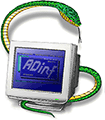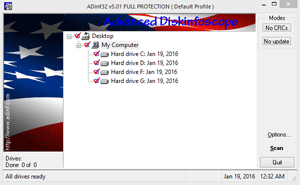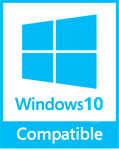Q: WHAT DOES ADinf DO ?
A: ADinf takes a "snapshot" of your computer, and compares it with
prior snapshots. A comparison of two snapshots allows you to see what has changed.
Q: WHY WOULD I WANT TO LOOK AT SUCH A COMPARISON?
A: Typically, you wouldn't. If your computer suddenly misbehaves,
you will find this comparison invaluable. You can identify documents mistakenly deleted, accumulated junk, etc.
Q: THIS SOUNDS LIKE COMPUTER MANAGEMENT - WHY IS ADinf DESCRIBED AS A VIRUS PROTECTION TOOL?
A: This IS computer management; sometimes called integrity management
(because you are monitoring the integrity of data on your computer).
It is also a virus protection tool for a number of reasons:
Click here to read more about the role of ADinf in providing antivirus protection.
- Missing, changed, or new files could be the result of virus infection.
- While taking a snapshot, ADinf takes an extra step and tests certain new files (executable files) to determine if they are viruses of a certain type ("stealth" viruses).
- Finally, ADinf becomes an actual user of your virus scanner - directing it to scan new or changed files. This last step is important if you failed to scan a newly added file, or if a new file which passed a scan then created a malignant "offspring" that would have failed the initial scan - ADinf would detect such offspring.
Q: THEN WHAT DOES MY VIRUS SCANNER DO?
A: Most computer users now have a virus scanner or scanner/monitor
that looks for viruses hidden in files (e.g. Email attachments), and
for active viruses (programs) operating in memory. The scanner will
usually call for deletion of a file found to contain a virus.
Q: SO IF A SCANNER DOES THAT, WHY DO I NEED ADinf?
A:
No scanner is perfect.
The scanner knows the viruses that are already in its database. New
viruses are designed to slip past the best scanners.
ADinf will see the impact of the new virus. These will be new ones
modified or deleted data files, as well as new or “infected” executable files.
Any of these effects will be detected by ADinf and reported to you.
During its existence, different generations of ADinf were the first
who discovered completely new camouflaging invisible viruses
and only later these viruses were included in the databases of antivirus scanners.
Q: SO MY COMPUTER ACTS UP, I CHECK ADinf AND FIND CHANGES OR
EVIDENCE OF A VIRUS, THEN WHAT?
A:
If you've accidentally deleted a file, you'll know which file and you can
replace it from your backup - or know that you need to recreate it.
If you've accumulated a lot of junk (e.g. temporary files), you'll
know to delete it. If you have a virus, you'll know to attempt to
disinfect your computer with a combination of Dr.Web (or other scanner)
and ADinf.
If your computer has been infected by a new virus, there's a good chance that no scanner will be yet able to find or disinfect your files. In that case, you use ADinf to identify and delete all new and changed executable files (virus files). In many situations, using ADinf alone would be the preferred way to clean boot viruses in an infected computer.
If your computer has been infected by a new virus, there's a good chance that no scanner will be yet able to find or disinfect your files. In that case, you use ADinf to identify and delete all new and changed executable files (virus files). In many situations, using ADinf alone would be the preferred way to clean boot viruses in an infected computer.
Q: WILL THIS BE ANOTHER **THING** FOR ME TO ATTEND TO ON MY COMPUTER?
Just periodically start ADinf, typically daily, and quickly review changes.
If ADinf finds a virus, or senses virus-like activity, it will alert you.
At that point, you would WANT to attend to this new thing.
Q: THIS INFORMATION IS EXTRAORDINARY - ALMOST TOO GOOD TO BE TRUE! WHY
HASN't THERE BEEN MORE USE OF THIS TOOL? WHY HAVEN't I HEARD MORE ABOUT IT?
A:
ADinf is currently used by THOUSANDS of important and sophisticated
institutions and individuals in Russia and other ex-Soviet Union
countries. ADinf has been proven in use, and officially recognized for more than 10 years!
Q: IS ALL OF THIS REALLY NECESSARY FOR A SIMPLE HOME USER? SEEMS WE HAVE DONE
PRETTY WELL WITH JUST A STANDARD SCANNER/MONITOR!?
A:
The "simple" home user of the past is quickly disappearing. Home computers
are becoming more powerful, more complex, and more dynamic - that fact
alone creating a need for an integrity management tool like ADinf.
Add an increasing use of the internet, and the home user becomes more susceptible than ever to damage by design. Sadly, virus construction has become a very sophisticated endeavor - the simple and mischievous viruses of just a few years ago are today becoming clever and VERY destructive. ADinf is an important and natural "next-step" in computer use - even for the "simple home user".
And finally, not a single antivirus scanner will save your family photos if for some reason they are erased or damaged. If you do not notice the loss in time, the backup copy will be overwritten and the pictures will be lost forever. ADinf32 allows you to detect loss in time and restore files from a backup copy. Personally, ADinf32 saved me a long-term photo archive in this way, for which I am very grateful to him!
Add an increasing use of the internet, and the home user becomes more susceptible than ever to damage by design. Sadly, virus construction has become a very sophisticated endeavor - the simple and mischievous viruses of just a few years ago are today becoming clever and VERY destructive. ADinf is an important and natural "next-step" in computer use - even for the "simple home user".
And finally, not a single antivirus scanner will save your family photos if for some reason they are erased or damaged. If you do not notice the loss in time, the backup copy will be overwritten and the pictures will be lost forever. ADinf32 allows you to detect loss in time and restore files from a backup copy. Personally, ADinf32 saved me a long-term photo archive in this way, for which I am very grateful to him!













